Chamber / Taperstick / Snuffer
Chamber / Taperstick / Snuffer
Browse our collection of antique silver Chambersticks, Tapersticks, Candle Snuffers and Stands, some of which date back to the 17th century.
Silver chambersticks first made an appearance in the 17th century and early examples are now very hard to find. Originally they were made in sets as a household would need many chambersticks. They were used for lighting the way to bed and because of the movement created when they were carried about they needed a large drip pan to catch the wax. The earliest examples have straight handles (first flat, then tubular) which were superseded in the first part of the 18th century by a ring handle. Gradually the design evolved and from the mid 18th century onwards they usually had a matching conical snuffer although from about 1790 onwards some were made with an aperture at the base of the stem to take a pair of scissor snuffers.
Silver tapersticks, averaging about 5 inches high, are miniature table candlesticks used to hold a wax taper. Tapersticks would typically be found on a desk as they were not used for lighting; the melted sticks of wax were used for sealing letters, to give a flame for tobacco pipes or to light large candles. They are rarer than candlesticks and very few existed prior to the Queen Anne period. They usually appear in singles and pairs of tapersticks command a premium price.
The silver wax jack appeared from circa 1775 and was a container or frame holding a long coiled taper treated with wax (sometimes turpentine). The wax was lit to melt the sealing wax used to fasten letters and documents and usually a personal seal was pressed into the hot wax to leave a personal identification. After the wax hardened it was virtually impossible to open the letter without breaking the wax seal. The wax jack could also used as a portable light such as the chamber stick or go to bed.
Silver candle snuffers and stands were vital pieces of equipment to enable candle lighting to be used efficiently. Two different types of candle douters were used to extinguish the flame of a candle:
– the candle snuffer with a small cone on the end of a long handle.
– the snuffer scissors, a dual purpose tool which could extinguish the candle flame and also cut the wick of the candle for reuse. The pointed end was used to loosen and remove candle stubs from the socket.
There were few snuffers made prior to 1700 and by the early nineteenth century more refined candles were introduced which no longer required the wick to be cut. Additional information available at http://www.oldandinteresting.com/tallow-candles-snuffers.aspx. Snuffer trays are usually rectangular or oval shaped and can sometimes be raised on feet or have a carrying handle. Some early stands, called standing snuffers, are shaped like a candlestick with a side carrying handle and a hole at the top where the point of the snuffer scissors is inserted – these were very quickly superseded by the flat snuffer tray and scissors. It is rare now to find matching snuffers and base. Snuffers and trays were usually made by different specialists so even though the dates match, the makers will probably be different.
-

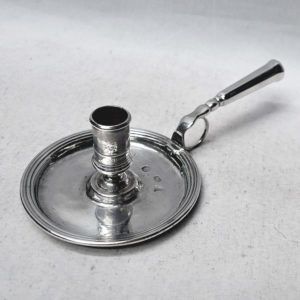
1685
John Penfold
8881 Antique James II Antique Silver Chamberstick
Sold
An extremely rare early English silver chamber stick (also known as a go to bed) with the solid design and excellent heavy gauge silver as you’d expect from this date. It has the early form with a long cannon handle and heavy bordered drip pan with a reeded edge. A nice feature is the ring handle support. The drip pan has hand engraved initials underneath. Weight 223 grams, 7.2 troy ounces. Diameter 11 cms. Length 22 cms. Sterling silver. London 1685. Makers mark probably John Penfold (see photo of Jacksons page 148).
-

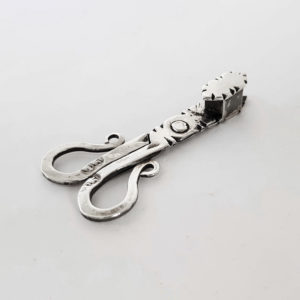
Circa 1685 - 1720
George Manjoy
9764 Antique Silver Miniature Candle Snuffers
Sold
A delightful little collector’s piece. A rare antique silver wick trimmer miniature, also called a candle douter. Britannia standard silver*. Weight 6 grams, 0.19 troy ounces. Length 4.8 cm. Width 2.2 cm. Circa 1700. Maker George Manjoy (c.1685-c.1720), specialist toy maker (see Jackson’s Silver & Gold Marks of England, Scotland & Ireland p.141).
-

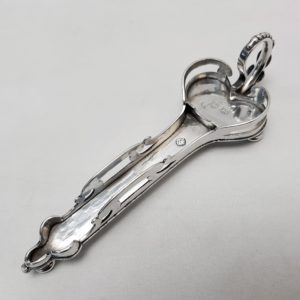
1685
Pierre Harache
10204 James II Antique Silver Snuffer Tray
Sold
A very rare piece of 17th century silver from the highly sought after Huguenot maker Pierre Harache. This Jacobean silver snuffer tray is of triangular form with a pierced gallery to hold a pair wick trimmers (not supplied) snugly in place. Weight 802 grams, 25.7 troy ounces. Spread 17cm. Platform size 14 x 4.8cm. London 1685. Maker Pierre Harache. Sterling silver.
-


1686
10450 James II Antique Silver Chamberstick
Sold
A distinctive little chamberstick (or “go to bed”) with the solid design and heavy gauge silver you’d expect from this date. It has the early form with a flat teardrop handle engraved with a family coat of arms. The circular pan has a gadrooned border and ribbed sconce, all mounted on three small stump feet. Weight 187g, 6 troy oz. Height 4.3cm. Diameter 9.7cm. Spread 15cm, 5.9ins. London 1686. Maker’s mark unclear. Sterling silver.
-

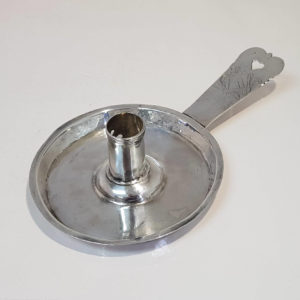
Circa 1693
9664 Charles II to William & Mary Silver Chamberstick
Sold
A rare early English silver chamber candlestick (also known as a go to bed) with the plain styling and hand beaten silver you’d expect from this date. It has a large drip pan and flat tongue shaped handle. The candle socket has 4 circular holes to enable the stub of the candle to be levered out. A nice feature is the shaped handle decoration and heart shaped hole for hanging when not in use. Hand engraved to the handle is an armorial within a decorative cartouche and on the reverse side there are two sets of prick initials and dates. “I.B 1694” and “D.W June 23rd 1693”. Weight 147 grams, 4.7 troy ounces. Diameter 12.9cm. Length 22.5cm. English Sterling silver. Prick marks Charles II to William and Mary date. Circa 1693. No hallmarks. The earliest prick date can be read as either 1664 or 1694 – see photos. In our opinion this is 1664. Makers mark “W.W” unidentified.
-

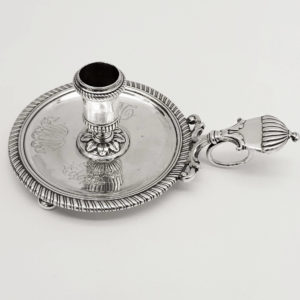
1696
Pierre Harache
9567 William III Silver Chamberstick
Sold
A rare early English silver chamberstick (or “go to bed”) with the solid design and heavy gauge silver you’d expect from this date. Sterling silver. It has the early form with flat teardrop handle. The circular pan has a gadrooned border and ribbed sconce, all mounted on three small stump feet. Hand engraved to the centre are 3 ornamental cyphers. Weight 222 grams, 7.1 troy ounces. Diameter 10.8 cm, 4.25 inches. Length 17 cms. London 1696. Maker Pierre Harache.
-

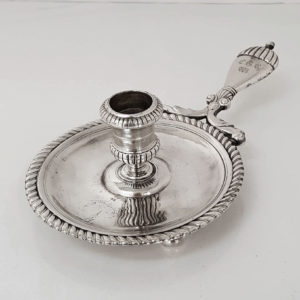
1697
9775 William III Silver Chamberstick
Sold
A rare early English silver chamberstick (or “go to bed”) with the solid design and heavy gauge silver you’d expect from this date. It has the early form with flat teardrop handle. The circular pan has a gadrooned border and ribbed sconce, all mounted on three small stump feet. Hand engraved to one side is a crest and motto. The handle is hand engraved with a set of initials typical of the period. Weight 295 grams, 9.4 troy ounces. Height 6.2 cm. Diameter 11.5 cm. Spread 21.4 cm. London 1697. Makers mark unclear. Britannia standard silver.
-

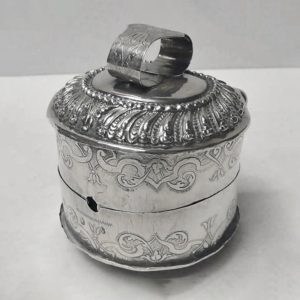
1701 - 1799
8439 Early Continental Silver Bougie Box
Sold
An unusual antique silver wax jack, or taper holder, with cut card work and flower decoration to the body. The wax coil would have been contained inside the drum shaped box. Weight 103 grams, 3.3 troy ounces. Height 8.5 cms. Width 7.5 cms (excluding handle). Diameter 7 cms. Marked on the front with an assay scrape, Nuremberg mark and makers mark. 18th century. German.
-

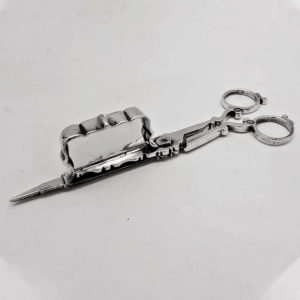
1701
Thomas Brydon
10371 William III Silver Snuffer Scissors
Sold
A rare early English silver candle douter, also called a wick trimmer, with the simple plain style typical of the period. *Britannia standard silver. Weight 94 grams, 3 troy ounces. Length 15.9cm. Width 5.5cm. London 1701. Few snuffers were made prior to 1700. Maker Thomas Brydon, see Jackson’s Silver & Gold Marks page 154, a known snuffers and stand maker.
-

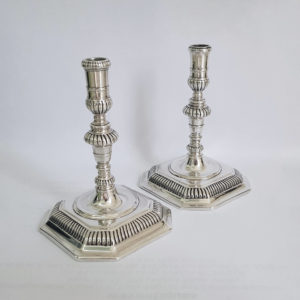
1702
Thomas Prichard
10278 Queen Anne Antique Silver Tapersticks
Sold
A stunning pair of little antique silver tapersticks with square bases and lobed, gadroon decoration. Superb quality. Lovely crisp finish. The technique of making cast silver sticks was introduced into England circa 1685 and this is one of the early designs. Weight 267 grams, 8.5 troy ounces. Height 9.8cm. Base 6.8cm. London 1702. Maker Thomas Prichard. Britannia standard silver. 18th century.
-

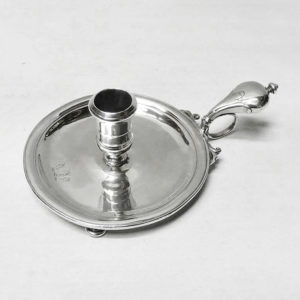
1704
Simon Pantin
7725 Queen Anne Silver Chamberstick
Sold
A rare early English silver chamber stick (also known as a go to bed) with the solid design and excellent heavy gauge silver as you’d expect from this date. It has the early form with a flat teardrop handle and broad drip pan. The circular base is hand engraved with the crest of a crowned lion’s head erased between two plumes, all mounted on three small stump feet. Weight 225 grams, 7.25 troy ounces. Diameter 11.5 cms, 4.5 inches. Length 17 cms. Britannia standard silver*. London 1704. By Simon Pantin.
-

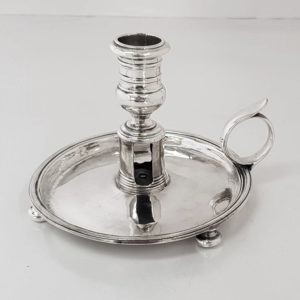
1704
Lewis Mettayer
9773 Queen Anne Silver Chamberstick
Sold
An antique silver chamber stick (also known as a “go to bed”) of plain circular form. Heavy gauge silver. Made in the early style with a ring handle and button feet. Weight 285 grams, 9.1 troy ounces. Height 9.8cm. Spread 14.5cm. Diameter 12.8cm. London 1704. Maker Lewis Mettayer. Of Huguenot origin. Britannia standard silver.
-

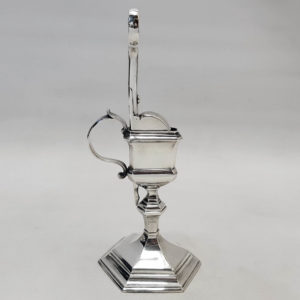
1706 - 1718
Matthew Cooper
10255 Queen Anne Antique Silver Snuffers and Stand
Sold
A rare early English silver snuffers and stand dating to the early 1700’s. The base, with a cast hexagonal stepped base and baluster stem, has the typical style of the candlesticks of this period. The snuffer scissors, known also as wick trimmers, sit longways in the stand, and the pointed end fits snugly into the stand’s retaining slot. Total weight 328 grams, 10.5 troy ounces. Height 22cm. Stand height 13.5cm, base diameter 7.8cm. Scissors length 14.7cm. London 1706/1718. Maker Matthew Cooper. *Britannia standard silver. 18th century
-

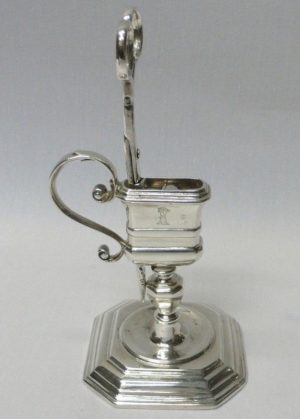
1707
Thomas Folkingham
8034 Queen Anne Antique Silver Snuffers and Stand
Sold
A very rare early English silver snuffers and stand with an octagonal stepped base and baluster stem. *Britannia standard silver. The cut corner square base has the typical style of the candlesticks of this period. The snuffer scissors, or wick trimmers, sit long ways in the stand. Both scissors and stand have identical hand engraved crests of a gauntlet holding up a crown. Total weight 317 grams, 10.2 troy ounces. Height 17.5 cms. Stand height 11.25 cms, base diameter 8 cms. Scissors length 14.25 cms. Both pieces have English silver hallmarks for London 1707. Maker Thomas Folkingham.
-

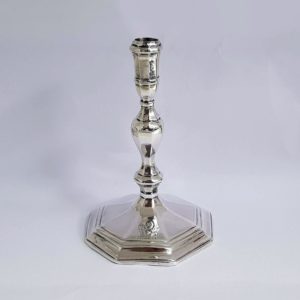
1707
Thomas Merry
10131 Antique Queen Anne Silver Taperstick
Sold
A charming little antique silver taperstick of plain early design with baluster stem and raised octagonal foot. Cast silver. Britannia standard silver*. Hand engraved on the foot is a lion crest. Weight 127 grams, 4.1 troy ounces. Height 11.8cm. Base diameter 7.7cm. London 1707. Maker Thomas Merry.
-

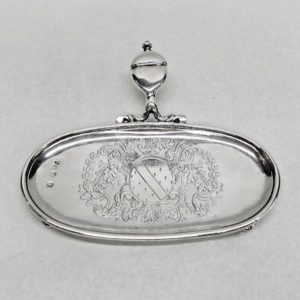
1710
Samuel Lea
9324 Queen Anne Silver Snuffer Stand
Sold
A rare early English silver snuffer tray of oval form with cast acorn handle and three ball feet, similar style to the early chambersticks of a contemporary date. Britannia standard silver*. Hand engraved to the centre with a family armorial contained within a large scroll cartouche. Weight 250 grams, 8 troy ounces. Spread 15.8 cm. Pan 18.6 x 9.2 cm. London 1710. Maker probably Samuel Lea (Charles J Jackson’s “English Goldsmiths and Their Marks”).
-

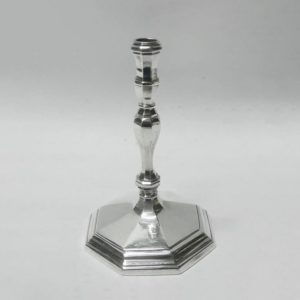
1710
William Twell
7751 Antique Queen Anne Silver Taperstick
Sold
A delightful little antique silver taper stick of plain early design with baluster stem and raised octagonal foot. Cast silver. Britannia standard silver*. Weight 115 grams, 3.6 troy ounces. Height 11.5 cms. Base diameter 7.6 cms. London 1710. Maker William Twell.
-

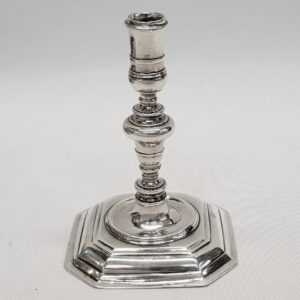
1711
Thomas Merry
9497 Queen Anne Silver Taperstick
Sold
A delightful little antique silver taper stick of plain early design with baluster stem and raised square foot with canted corners. Cast silver. Britannia standard silver*. Weight 104 grams, 3.3 troy ounces. Height 9.5cm. Base diameter 7cm. London 1711. Maker Thomas Merry I.
-

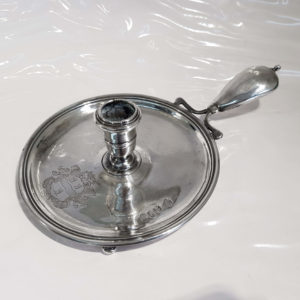
1711
Joseph Bird
10161 Queen Anne Antique Silver Chamberstick
Sold
A rare early English silver chamberstick (also known as a go to bed) with the solid design and excellent heavy gauge silver as you’d expect from this date. It has the early form with a flat teardrop handle and a broad drip pan mounted on three small stump feet. The circular base has a decorative cartouche hand engraved with the coat of arms for the Miller baronets of Chichester, Sussex. Weight 242 grams, 7.7 troy ounces. Diameter 4.5cm. Length 23cm. Britannia standard silver. London 1711. Maker Joseph Bird.
-

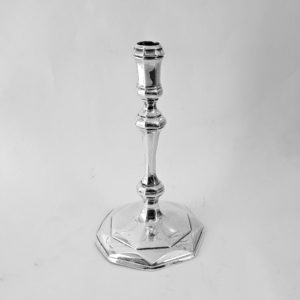
1713
John Barnard
10158 Queen Anne Antique Silver Taperstick
Sold
A lovely little antique silver taperstick of plain design with knopped tapering stem and raised faceted foot. This straight lined octagonal shape is a very rare and desirable feature. Britannia standard silver*. Weight 101 grams, 3.2 troy ounces. Height 12cm. Base diameter 6.7cm. London 1713. Maker John Barnard.
-

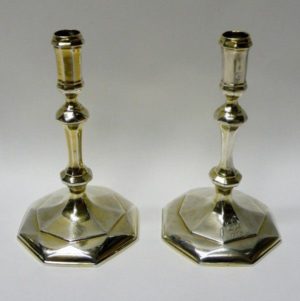
1714
Thomas Merry
8600 Antique George I Silver Tapersticks
Sold
A delightful pair of little antique silver taper sticks with the plain early design of baluster stem over a spreading hexagonal foot with diamond cutting. Cast silver. Britannia standard silver*. With a monogram over the date 1714 hand engraved to the base. Traces of the original gilding. Total weight 184 grams, 8.7 troy ounces. Height 12 cms. Base diameter 7 cms. Marked underneath the base with clear English silver hallmarks for London 1714. Maker Thomas Merry I.
-

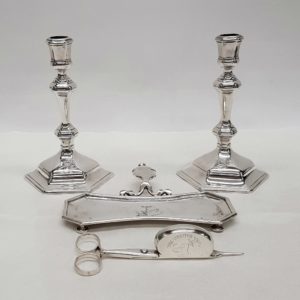
1716
David Greene
9363 George I Antique Silver Snuffer Set
Sold
It is extremely unusual to find a completely matching 4 piece desk set of this early date. The suite consists of silver candlesticks, silver snuffer tray and silver snuffer scissors. All with a matching hand engraved crest and motto “Nec Tollitur Undis – “No Water is Removed”. Britannia standard silver*. Lovely plain style in keeping with the period.
Candle snuffer scissors – the simple open and shut mechanism retains the original steel cutting plates. Weight 93 grams. Length 14.7 cm.
Snuffer stand – with cast acorn handle and four ball feet, similar style to the early chambersticks of that date. Weight 183 grams. Pan 17.1 x 6.3cm. Spread 11.7cm.
Cast candlesticks – with hexagonal form, baluster column and stepped spreading bases. Weight 596 grams, 19.1 troy ounces. Height 17.2cm. Base 11cm.
London 1716. Maker David Greene. -

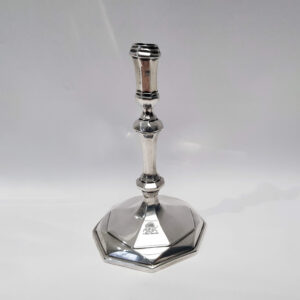
1716
Joseph Bird
10422 George I Antique Silver Taperstick
Sold
A delightful little antique silver taper stick of plain early design with knopped, faceted, baluster stem on a raised octagonal foot. Cast silver. Hand engraved to the front of the foot is a family crest. The straight lined octagonal shape is a rare and desirable feature. Weight 84 grams, 2.7 troy oz. Height 11.5cm, 4.5ins. Base diameter 7.2cm, 2ins.
London 1716. Maker Joseph Bird. Marks. Stamped underneath with a full set of English silver hallmarks. Britannia standard silver, purity 95.8%. -

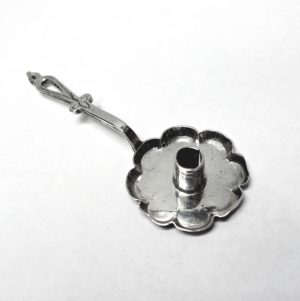
Circa 1720
8869 Antique Dutch Silver Miniature Chamberstick
Sold
A lovely little antique silver toy chamberstick with the long handle typical of the period. It looks like an exact copy of a full size original. Length 7.2 cms. Diameter 2.7 cms. Marked underneath with a Dutch makers mark*. Hoorn, Netherlands. Circa 1700.
-

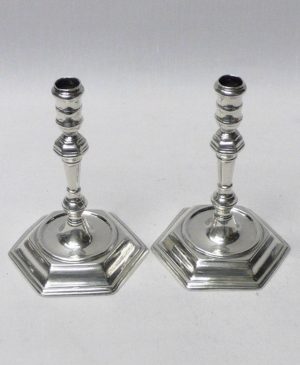
1721
8097 George I Antique Silver Tapersticks
Sold
A delightful pair of little antique silver taper sticks with the plain early design of baluster stem over a raised hexagonal foot. Cast silver. Britannia standard silver*. With scratched initials “C” over “RM” under the bases. Total weight 273 grams, 8.7 troy ounces. Height 11.5 cms. Base diameter 7.25 cms. Marked in the corners underneath the base with English silver hallmarks for London 1721. Makers mark unclear.
-

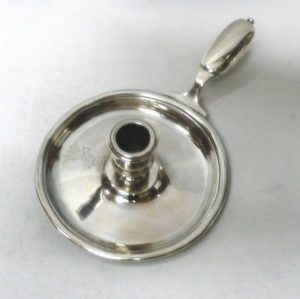
1722
James Fraillon
8639 George I Silver Chamberstick
Sold
A rare early English sterling silver chamber stick (also known as a go to bed) with the solid design and excellent heavy gauge silver as you’d expect from this date. It has the early form with a flat teardrop handle and broad drip pan. The circular base is hand engraved with the crest of a crown over a gentleman carrying a double scythe. Weight 400 grams, 12.8 troy ounces. Diameter 14.5 cms. Length 23.5 cms. London 1722. By James Fraillon.
-

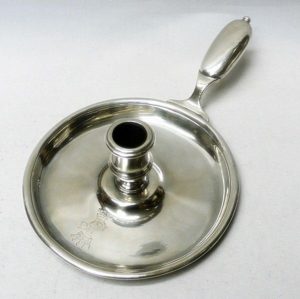
1722
James Fraillon
8640 George I Antique Silver Chamberstick
Sold
A rare early English silver chamber stick (also known as a go to bed) with the solid design and excellent heavy gauge silver as you’d expect from this date. It has the early form with a flat teardrop handle and broad drip pan. The circular base is hand engraved with the crest of a crown over a gentleman carrying a double scythe. Weight 399 grams, 12.8 troy ounces. Diameter 15 cms. Length 25 cms. Britannia standard silver*. London 1722. By James Fraillon.
-

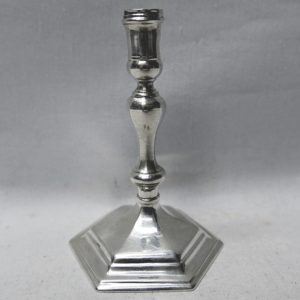
1722
Benjamin Pyne
8763 Antique George I Silver Taperstick
Sold
A delightful little antique silver taper stick of plain early design with baluster stem and raised hectagonal foot. Cast silver. Weight 112 grams, 3.6 troy ounces. Height 11 cms. Base diameter 6.8 cms. London 1722. Maker Benjamin Pyne.
-

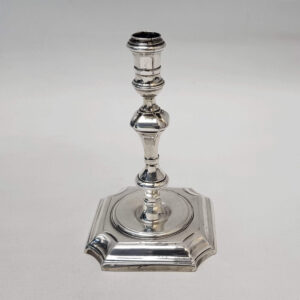
1723
David Willaume
10319 George I Antique Silver Taperstick
Sold
A classic little antique silver taperstick with knopped stem and rectangular base. Nice plain style and straight lines. Cast silver. Weight 100 grams, 3.2 troy oz. Height 10.5cm. Diameter of base 6.7cm. London 1723. Maker David Willaume I. Sterling silver.
-

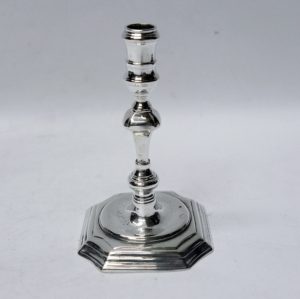
1724
John Bache
9066 Antique George I Silver Taperstick
Sold
A delightful little antique sterling silver taper stick of plain early design with baluster stem and square octagonal foot with a sunken well. Cast silver. Weight 72 grams, 2.3 troy ounces. Height 10 cms. Base diameter 6.5 cms. London 1724. Maker John Bache.
-

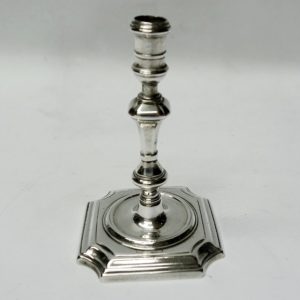
1725
Joseph Healy
9144 Antique George I Silver Taperstick
Sold
A delightful little antique sterling silver taper stick of plain early design with baluster stem and square octagonal foot with a sunken well. Cast silver. Weight 116 grams, 3.7 troy ounces. Height 11 cms. Base 7×7 cm. London 1725. Maker Joseph Healy.
-

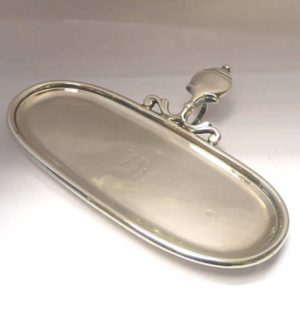
Circa 1725
John Hamilton Of Dublin
6519 Antique Irish Silver Snuffer Tray
Sold
A fine piece of early Irish silver. A plain styled snuffer tray of simple oval shape with a shaped side handle and round feet. To the centre there is an engraved crest. This is a very charming item, it handles well and the colour is excellent. Very good weight 214 grams, 6.8 troy ounces. Length 18 cms. Width 7.75 cms, 13.5 including handle. Makers mark only for John Hamilton. Dublin circa 1725.